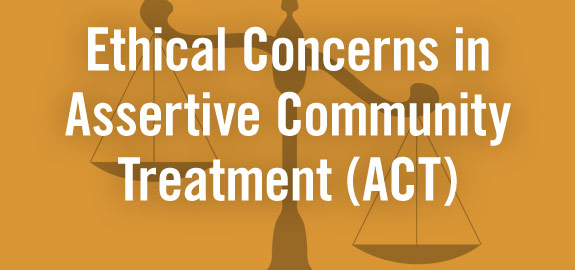Some critics call Assertive Community Treatment (ACT) a fundamentally coercive model of care because of the level of control that case managers have over their clients’ lives. This article explores some of the resulting ethical concerns of using the ACT model. This article is the third in a series of three articles about ACT.

Embedded in Assertive Community Treatment (ACT) is the element of, well, assertion on the part of service providers. This has led some critics to call ACT a fundamentally coercive model of care. And indeed, many ACT providers find the balance between social control and client independence a very difficult one to strike.
Social Control versus Client Independence
Traditionally, mental health treatment has focused on acting in the best interest of the client. ACT, however, has been accused of being more concerned with benefits to systems instead of individuals. ACT’s community-based approach has its roots in inpatient psychiatric care. Because of this, the idea of patient independence or freedom has been very limited from its earliest beginnings.
These roots can be seen in various forms of social control that are still present in ACT. For instance, ACT staff has the power to force clients into hospitalization, or to remove them from a homeless shelter or drop-in center. They may also demand that clients change their behavior, forcing them to take medication or abstain from alcohol, for instance. If clients do not comply, they may face loss of personal freedom.
ACT staff may also control many other aspects of clients’ lives. They may manage flow of money for clients, their access to doctors and pharmacies, decisions about treatments, and contact with their social networks. The ongoing ethical challenge for ACT staff is to strike a balance. They need to empower clients without neglecting them, care for them without controlling them too much, and give them as much independence as possible even while intervening in their lives.
ACT: A Coercive Model?
It is easy to see how some would perceive coercion to be woven into all aspects of ACT. And it is true that this can happen in many ways. However, some ACT clients are at the extreme end of psychosis. They may suffer a great deal because of their untreated symptoms. Moreover, their experiences may render them unable to understand their illness and their right to humane treatment. In such cases, compassionate coercion may be what allows ACT staff to fulfill their client’s right to this treatment.
It may be helpful to think of coercion on a continuum. At one end is friendly persuasion, in the middle is control of resources, and at the other end of the spectrum is the use of force in treatment. The level of involvement from the case worker depends on many factors, most especially the severity of the case.
What do the critics think?
There are many different players involved in Assertive Community Treatment. Of course, the main players are the clients themselves and their teams of providers, but there is also a diverse community of people who are interested in treatment outcomes.
ACT clients are largely lower-income, rely on public assistance, and have historically had minimal input into their own treatment to begin with. Critics of ACT say treatment that is forced upon individuals is inherently coercive (especially individuals with limited options, as described above). They see this as especially true because a person enrolled in ACT cannot end these services.
Criticism of ACT goes beyond the question of coercion, though. Some doubt the positive outcomes for ACT clients. They argue that the results seen with ACT are not actually all that different from standard treatment, and concerns about the design of studies comparing the two have also been raised.
In addition, critics say that the greatest benefit of ACT (reduced hospitalizations for clients) is not a result of the intervention itself. They see this as simply a part of the design of the model, and administrative distinctions which seek to move clients away from hospitals in general.
What do clients think?
In some ways, it is not surprising that clients themselves did not have a voice in the debate surrounding ACT until decades after the model was developed. But in the mid-1990s, the academic community did start asking clients about their experiences with the program.
Some studies looked at the most important factors in client satisfaction. They found that for clients, these included having consistent contact with staff, supportive services, a positive helping alliance, and a sense of trust and caring by ACT staff. Other studies found that clients enrolled in ACT were happy with housing assistance and the help they received in adjusting to their communities.
The feedback wasn’t all positive, though. One study found that even though clients were satisfied with many aspects of care, they were not happy with medication and treatment issues. Clients in another study said they disliked what they saw as “program intrusiveness.” They felt that the program was too confining and echoed earlier sentiments that there was too much of a focus on medication compliance.
In the end, the question of coercion in ACT may be largely a matter of opinion. But what is less subjective is the issue of balance, as service providers are pulled between control over and independence for their clients.
